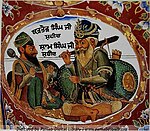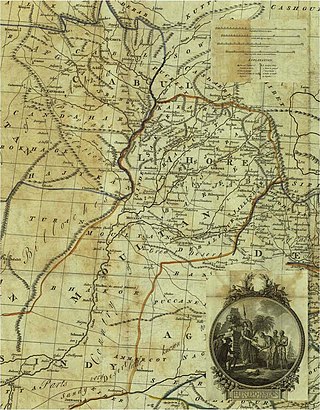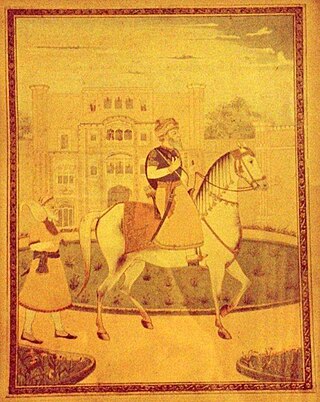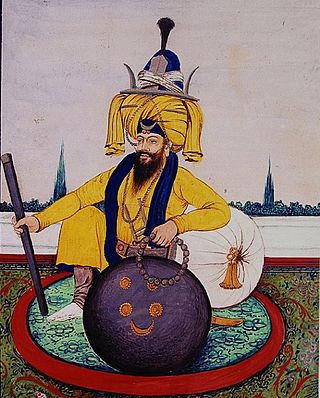This article needs additional citations for verification .(April 2022) |
| Misls of the Sikh Confederacy |
|---|
 |
The Singh Krora or Karorsinghia Misl, also known as the Panjgarhia Misl, was a Sikh misl. [1]
This article needs additional citations for verification .(April 2022) |
| Misls of the Sikh Confederacy |
|---|
 |
The Singh Krora or Karorsinghia Misl, also known as the Panjgarhia Misl, was a Sikh misl. [1]
Sirdar Karora Singh Virk, resident of Barki (district Lahore) was the first chief of this Misl; earlier, Karora Singh was the deputy of the jatha led by Sirdar Sham Singh of village Narli (district Lahore); after the death of Sham Singh in 1739, Sirdar Karam Singh Uppal (of village Pechgarh) became the chief of this Jatha; he too died in early days of 1748 and Karora Singh became the chief of the Jatha. [2]
In March 1748, when the Misls were formed, his jatha became a Misl; then this jatha came to known as Karorsinghia Misl. Karora Singh had the command of 7-8 thousand horsemen; his first possessions were Hariana and Sham Churasi (in Hoshiarpur district); Karora Singh died in the Battle of Taravari in 1761.
Karora Singh was succeeded by Baghel Singh Dhaliwal of Jhabal (district Amritsar); Baghel Singh was fond of adventures; he left the Majha area and launched his actions in Karnal, Saharanpur and other areas of Gang-Doab; he was one of those five generals who unfurled blue Khalsa flag on Red Fort at Delhi on 11 March 1783.
Baghel Singh had an army of thirty thousand soldiers; the ground where his army used to pitch its tents is still known as Tees Hazari (literally: associated with thirty thousands). Baghel Singh died in 1802; he was succeeded by his wife Rattan Kaur.
| No. | Name (Birth–Death) | Portrait | Reign | Ref. | |
|---|---|---|---|---|---|
| 1 | Sham Singh (died 1739) |  | ? – 1739 | [3] | |
| 2 | Karam Singh | ? | ? | [3] | |
| 3 | Karora Singh (died 1761) | ? | ? – 1761 | [3] | |
| 4 | Baghel Singh (died 1802) |  | 1761 – 1802 | [3] | |
| 5 (disputed) | Jodh Singh (born 1751) | Sukhu Singh | ? | 1802 – ? | [3] |
| 6 | Rattan Kaur (died 1848) | ? | ? – 1848 | [3] | |

The Sukerchakia Misl was one of twelve Sikh misls in Punjab during the 18th century, concentrated in Gujranwala and Hafizabad districts in western Punjab and ruled from (1752–1801). The misl was founded by Charat Singh of Sandhawalia, grandfather of Maharaja Ranjit Singh. The last Sukerchakia Misldar was Maharaja Ranjit Singh. Towards the end of the eighteenth century, Maharaja Ranjit Singh united all the misls and established an independent Sikh Empire.

Dal Khalsa was the name of the combined military forces of 11 Sikh misls that operated in the 18th century (1748–1799) in the Punjab region. It was established by Nawab Kapur Singh in late 1740s.

The Sikh Confederacy was the confederation of the twelve sovereign states. which rose during the 18th century in the Punjab region in the northern part of the Indian subcontinent and is cited as one of the causes of the weakening of the Mughal Empire prior to Nader Shah's invasion of India (1738–1740).

Sultan-ul-Qaum Sardar Jassa Singh Ahluwalia was a Sikh leader during the period of the Sikh Confederacy, being the Supreme Leader of the Dal Khalsa. He was also Misldar of the Ahluwalia Misl. This period was an interlude, lasting roughly from the time of the death of Banda Bahadur in 1716 to the founding of the Sikh Empire in 1801. He founded the Kapurthala State in 1772.

Baghel Singh was a Military general in the Punjab region in the northern part of the Indian subcontinent in the 18th century. He rose to prominence in the area around Sutlej and Yamuna. Singh joined the Singh Krora Misl, one of the misls during Sikh Confederacy. In 1765, Singh became the leader of the misl.

Kapurthala State, was a kingdom and later Princely state of the Punjab Province of India. Ruled by Ahluwalia Sikh rulers, spread across 510 square miles (1,300 km2). According to the 1901 census the state had a population of 314,341 and contained two towns and 167 villages. In 1930, Kapurthala became part of the Punjab States Agency and acceded to the Union of India in 1947.

The Dallewalia misl was founded by Sardar Gulabi singh a Khatri Sikh as a Jatha but later Succeeded by a Jatt Sikh Sardar Tara Singh Ghaiba of Kang Clan Tara Singh made the Jatha into a powerful Misl in the 18th century India. The founder of this Misl was Sardar Gulab Singh resident of the village of Dallewal near Dera Baba Nanak, in Doaba Bist Jalandhar. He took Pahul and became an active member of the Dal Khalsa in 1726 A.D and launched upon a career of chivalry, fighting against the tyrannical government of the Punjab. One day at the head of 150 comrades, he attacked Jalandhar and having obtained a rich booty all of them returned to their camp in the jungle safely.

The KanhaiyaMisl was one of the twelve misls of the Sikh Confederacy. It had been founded by Sandhu Jats.

The Nakai Misl, founded by Sandhu Jats, was one of the twelve Sikh Misls that later became the Sikh Empire. It held territory between the Ravi and Sutlej rivers southwest of Lahore in what became Pakistan. The misl fought against the Sials, the Pathans and the Kharals before it was incorporated into the Sikh Empire of the Sukerchakia Misl by Ranjit Singh.

The Bhangi Misl was a large and powerful Sikh Misl headquartered in Amritsar. It was founded in the early 18th century by Sardar Chhajja Singh Dhillon, who was baptised by Banda Singh Bahadur. The misl received its name "Bhangi" because Chhajja Singh and his soldiers frequently used the herbal intoxicant bhang. It was a first misl to established a Khalsa Raj and publish Khalsa currency coins. The Bhangi Kingdom/Misl was founded by Dhillon Jats.

Sardar Gujjar Singh Bhangi was a Sikh warrior of the Bhangi Misl, and one of the triumvirates who ruled over Lahore prior to the leadership of Maharaja Ranjit Singh.
Sobha Singh Kanhaiya of Niazbeg, his first name is alternatively spelt as Suba or Soba, was one of the triumvirates who ruled over Lahore, alongside sardars Lehna Singh Kahlon and Gujjar Singh of the Bhangi Misl, prior to the leadership of Maharaja Ranjit Singh.

Baba Darbara Singh, also known as Diwan Darbara Singh, was second Jathedar of Budha Dal and third leader of the Akal Takht. He should not be confused with other Darbara Singh of Sirhind who fought in the Battle of Anandpur.

The Nishanwalia Misl, also spelt as Nishananvali Misl, was a Sikh misl.

Ramgarhia Misl was a sovereign state (misl) in the Sikh Confederacy of Punjab region in present-day India and Pakistan. The misl's name is derived from Qila Ramgarh, a place located in Ramsar, near Amritsar, which was fortified and redesigned by Ramgarhia Misl chief Jassa Singh Ramgarhia. The Ramgarhia Misl was one of the twelve major Sikh misls, and held land near Amritsar.
Sardar Gulab Singh was the founder of Dallewalia Misl, one of the sovereign states of the Sikh confederacy that rose during the 18th century in the Punjab region. The Dallewalia and Nishanwalia Misl were stationed as a reserve force at Amritsar to protect the holy city and tackle any emergency. The Amritsar and the Punjab region was subject to raids by the Afghans led by Ahmad Shah Abdali therefore the Sikhs had created misls to defend the Punjab region and push back the invaders.
Sardar Ran Singh Nakai was the third chief of the Nakai Misl. He was born to the aristocratic Sandhu family of Jat Sikhs. He distinguished himself at an early age in campaigns with his father, Natha Singh Sandhu and uncle, the legendary Heera Singh Sandhu who was the founder of the Misl. Ran Singh was a fierce warrior and a powerful misldar under his leadership the misl was at its highest. He was the father of Maharani Datar Kaur and the father-in-law of Maharaja Ranjit Singh, the founder of the Sikh Empire. He was the grandfather of Maharaja Kharak Singh, the second king of the Sikh Empire and Sardar Kahan Singh Nakai, the last chief of the Nakai Misl.
Sardar Kahan Singh Nakai was the sixth and the last chief of the Nakai Misl. He was the grandson of the famous Sikh chief, Ran Singh Nakai and Sardarni Karmo Kaur. His aunt, Maharani Datar Kaur was the wife of Maharaja Ranjit Singh, founder of the Sikh Empire; thus making him the nephew of the Sher-e-Punjab. From an early age he assisted his father in campaigns and even commanded campaigns assigned to him by his uncle, Maharaja Ranjit Singh. His cousin, Kharak Singh went to become the second Maharaja of the Sikh Empire. He was the uncle of the third Maharaja, Nau Nihal Singh.
Sardarni Karam Kaur popularly known as Karmo Kaur was the wife of Ran Singh Nakai,the third ruler of the Nakai Misl. She served as the regent of the Nakai Misl during the reign of her sons, Bhagwan Singh and Gyan Singh. Being the mother of Maharani Datar Kaur, she was the mother-in-law of Maharaja Ranjit Singh, the founder of the Sikh Empire. She was the grandmother of Maharaja Kharak Singh, the second king of the Sikh Empire and Sardar Kahan Singh Nakai, the last chief of the Nakai Misl.
Dasaundha Singh was the first chief of Nishanwalia Misl.